Surreal in Oregon
Malheur National Wildlife Refuge, Oregon, US, February 24, 2016 -- Four days into what became known as the Oregon standoff, I stood in freezing fog at the Harney County Fairgrounds and wondered how long it has been -- if ever -- that the place had been that busy.
Harney county is rural. Roughly the size of the US state of Massachusetts, or the country of Haiti, it has a population of just 7,000 souls. Many of those souls like solitude. They don’t often attend public gatherings. They don’t like to be around police. But here they were, streaming into a hall filled with cops to find out exactly what was going on at a wildlife refuge 30 miles (about 50 kilometers) away.
It seemed surreal.
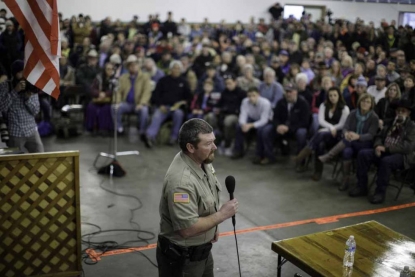 Harney County Sheriff David Ward addresses the community meeting at the fairgrounds on January 6, 2016. (AFP / Rob Kerr)
Harney County Sheriff David Ward addresses the community meeting at the fairgrounds on January 6, 2016. (AFP / Rob Kerr)Surreal is a good word to describe the 41-day standoff between law enforcement and a mishmash group protesting the power of the US federal government. For those who don’t come from the American West, that concept may seem surreal in and of itself -- armed citizens railing against the government. But here in the West, the “feds” is often a dirty word -- like it was amid that crowd at the fairgrounds. It all comes down to the land.
All about the land
In many Western US states, the majority of the land (53 percent in Oregon) is owned by the federal government. It’s public land, with people like ranchers or timber businesses given rights of use for grazing or clearing. Often ranchers resent the government control -- they figure they are the ones working the land, so they are the rightful owners. So disputes flare.
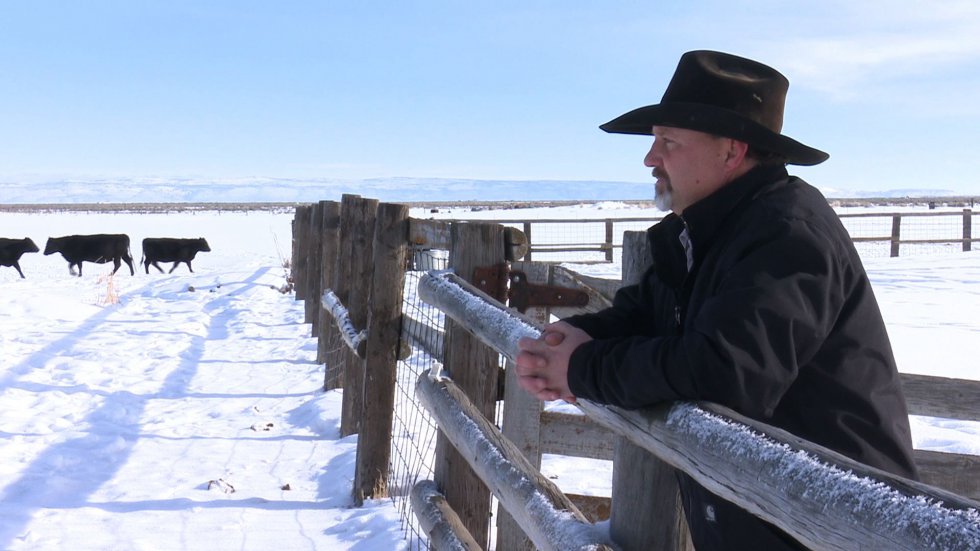
Click here to watch on a mobile device
One such dispute sparked the Oregon standoff. Two ranchers were convicted of setting fire to federal lands and sentenced to time in prison. To protest their sentences, Ammon and Ryan Bundy (their father was involved in a standoff with federal authorities in Nevada last year) and several of their supporters armed themselves with guns and took over the headquarters of the Malheur Wildlife Refuge, which is on public property in Oregon.
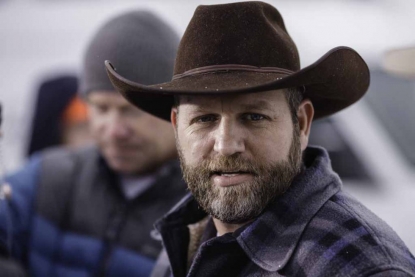 Leader of the occupiers, Ammon Bundy. January 5, 2016. (AFP / Rob Kerr)
Leader of the occupiers, Ammon Bundy. January 5, 2016. (AFP / Rob Kerr)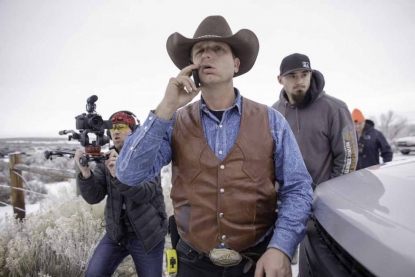 Occupier Ryan Bundy speaks on his cell phone. January 7, 2016. (AFP / Rob Kerr)
Occupier Ryan Bundy speaks on his cell phone. January 7, 2016. (AFP / Rob Kerr)Never mind that the ranchers whose sentencing sparked the protest distanced themselves from the armed group. The Bundys quickly attracted a crowd of followers, including self-described military patriots and others who seemed lost in life, including many Iraq war veterans. What they all had in common was a hatred for the “feds.”
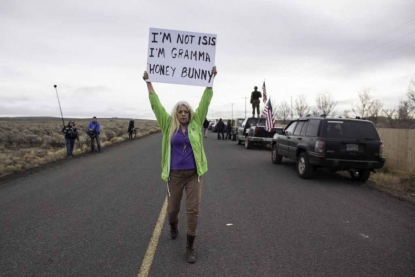 Supporters of the occupiers. February 11, 2016. (AFP / Rob Kerr)
Supporters of the occupiers. February 11, 2016. (AFP / Rob Kerr)In Oregon, the resentment of Washington is also fueled by the decline of the timber industry, which used to employ a massive amount of people in the state. At the end of the 1990s, logging on federal land was reduced to protect endangered and threatened species. Communities were given federal subsidies to help make up for the lost revenue. The money was temporary, as those communities established new economies. But many hadn’t when the subsidies started to expire a few years back. So the locals blame “the feds” for cutting their livelihoods, the timber industry, then cutting back on the subsidies that kept them afloat. There is often a sense of powerlessness here.
That sense was on display that night at the fairgrounds, when authorities held a community meeting to discuss how they were dealing with the armed takeover. In the days immediately following the takeover, confusion reigned -- noone knew exactly how many people were at the refuge, who they were, or what they wanted. Schools shut down for safety reasons. The local hospital boosted its staff, just in case. The nearby town of Burns was flooded with police. People stayed home with their curtains shut.
On top of that, the Internet is not widespread in this community. So the locals came to the fairgrounds to find out exactly what was going on.
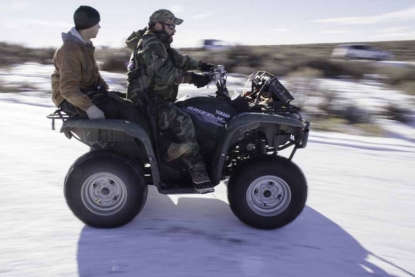 Two of the occupiers, armed with rifles, ride a four-wheeler. January 15, 2016. (AFP / Robb Kerr)
Two of the occupiers, armed with rifles, ride a four-wheeler. January 15, 2016. (AFP / Robb Kerr)As I stomped my feet to keep balance in the chunky snow, the parking lot filled up with trucks, passenger cars, media vans and a half-dozen sheriff vehicles from all over the state. A truck got stuck and instantly a group of volunteers from a variety of backgrounds helped pull it out.
The frustration and the fear that the Harney County residents expressed that night echoed so many things that rural communities in Oregon suffer. The sudden loss of control. The search for a new economy after the timber industry left town. The reality that a group can come in and change their lives.
As the meeting went on, I looked around and saw some of the refuge occupiers in the crowd, along with police, ranchers and small business owners. Wow, they were traveling freely on and off of the refuge? How were they not getting arrested? Another surreal moment.
Someone is watching you
I arrived the day after the occupation began, in the evening. I was chasing daylight and felt nervous approaching the wildlife refuge headquarters located 30 miles on an icy two-lane highway from Burns -- I had no idea how the armed men inside would feel about a photographer coming to take pictures of them. And then there was the watchtower.
In a sparse landscape of seemingly endless rolling hills, the watchtower jutting into the sky near the refuge was visible immediately. I had the feeling that I was being watched, closely. It was an eerie sight, which greeted me every day of the standoff.
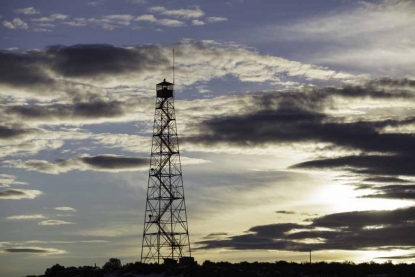 The watchtower next to the occupied headquarters. January 5, 2016. (AFP / Rob Kerr)
The watchtower next to the occupied headquarters. January 5, 2016. (AFP / Rob Kerr)During the first few weeks, police stayed away from the refuge itself. They secured a several block-sized headquarters next to the county courthouse in Burns and the FBI set up its headquarters at the airport.
There were two entrances to the refuge. The main one was remade into a checkpoint of sorts by the occupiers. Slightly larger than a basketball court, it was usually jammed with media vehicles. Locals would drive by occasionally to see what was going on. Some would stop and shout an opinion.
A second entrance to the refuge was usually just blocked by an empty car. During those first weeks, the media were allowed to roam the headquarters unhindered for a few hours around lunchtime. I can’t say I was ever completely comfortable during those moments. We were inside with armed men, some of whom insisted they had divine backing for their actions, and no police around. Bit surreal to say the least.
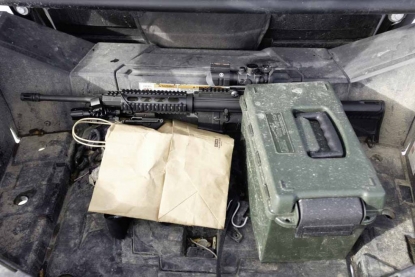 Firearms and ammunition in the back of an occupier's truck. January 15, 2016. (AFP / Rob Kerr)
Firearms and ammunition in the back of an occupier's truck. January 15, 2016. (AFP / Rob Kerr)Three weeks into the standoff, Ammon and Ryan Bundy were arrested on a highway around 50 miles from the refuge in an incident that left the spokesman for the group, Robert “LaVoy” Finicum dead.
Following that incident, the police presence increased drastically and I spent most of my time walking, eating and talking with police. Without their leaders, many of the occupiers began to leave and disappear into their former lives.
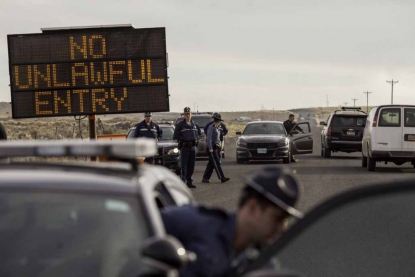 The road to the refuge blocked. February 11, 2016. (AFP / Rob Kerr)
The road to the refuge blocked. February 11, 2016. (AFP / Rob Kerr)The final week, when just four holdouts remained, FBI agents were everywhere and had the place sealed off completely. The FBI asked all media to leave the area and asked area ranchers to leave their homes if they could. Some did, others stayed to tend to their cattle. That last week the entire refuge was surrounded by the FBI, with roadblocks all over the place.
Which side are they on?
One afternoon I found myself photographing one of these remote checkpoints. After weeks of really frigid weather, on this day the sun was shining and the wind was gentle. The roadblock was on a gravel road that stretched dead-straight between miles of sage. It seemed that any activity, particularly vehicles on the dusty road would be easy to spot.
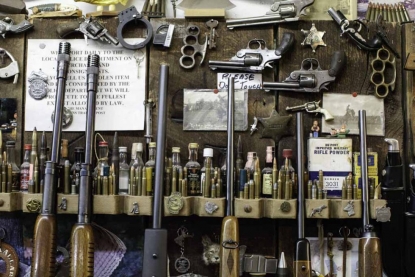 Guns and ammunition for sale in Burns, Oregon. January 5, 2016. (AFP / Rob Kerr)
Guns and ammunition for sale in Burns, Oregon. January 5, 2016. (AFP / Rob Kerr)But somehow I did not spot nearly a half a dozen large American pickup trucks block the road behind me. When I saw them, I wasn’t sure which side of the standoff the dozen of military-armed people approaching me were on. Guns trained on me, they ordered me out of my car with my hands up. They turned out to be FBI. After the initial tension, both their and my nerves calmed. They asked me what types of things I had seen in the weeks before. I didn’t have much to share.
Surreal ending to a surreal story
Adding to the surrealism of the situation was the setting -- the beautiful landscape of the wildlife refuge. People carried forth about the right to bear arms and their frustration as to who owns the land against the background of quail and pheasant roosters.
One of the occupiers, Duane Ehmer, wearing a leather jacket with the U.S. Flag on the back, would ride or walk his horse Hellboy around the occupied federal compound. A rancher would comment on Ehmer's riding skills.
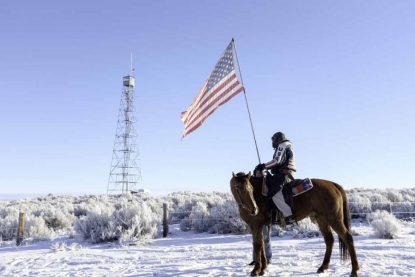 Duane Ehmer and Hellboy at the entrance to the refuge. January 15, 2016. (AFP / Rob Kerr)
Duane Ehmer and Hellboy at the entrance to the refuge. January 15, 2016. (AFP / Rob Kerr)Deer often dotted the frozen wetlands in the horizon and cattle picked over their feeding. The landscape changed from fog to snow and wind, with beautiful light over vast distances.
Deer were a constant presence for those covering the standoff. Many people hit them with their vehicles as they drove on remote roads covered in ice and snow. One guy managed to hit two deer in a single incident.
Quiet no more
I think one of the most poignant things about this story was its effect on the locals. They went from a sleepy rural area to one suddenly crawling with massive numbers of police, armed citizen militias and media. When you’re getting a haircut in your barber shop and all of the sudden an Oregon state police explosives vehicle pulls up out front, well, that can be disconcerting. Without reliable channels of communication, most of the time the locals just wondered what the heck was going on.
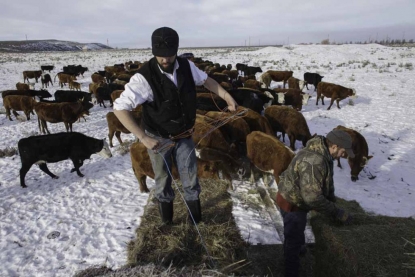 Area ranchers Tucker and Andy Dunbar on their ranch near the refuge. January 6, 2016. (AFP / Rob Kerr)
Area ranchers Tucker and Andy Dunbar on their ranch near the refuge. January 6, 2016. (AFP / Rob Kerr)Many of the locals shared the occupiers’ feelings toward the “feds.” But they really, really resented that the occupiers -- all of whom can from out of state -- decided to make their stand in their backyard. There was also resentment that the occupiers took the wildlife refuge -- a pristine spot beloved by all here -- as their target. They didn’t take care of it well, there was garbage everywhere and the locals really resented that, too.
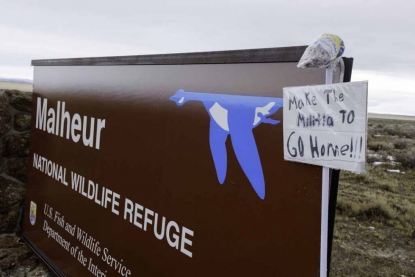 A refuge sign on January 29, 2016. (AFP / Rob Kerr)
A refuge sign on January 29, 2016. (AFP / Rob Kerr)Of course, there was an upside for local businesses, from the sudden activity, with some saying they had made as much in a month as normally they make in a season. But most of the time, I just really felt for the locals.
In line with the entire occupation, the standoff ended on February 12 in a somewhat surreal manner as well. The last of the four armed occupiers holed up in the refuge headquarters, 27-year-old David Fry, gave himself up after a rambling diatribe live-streamed online in which he demanded a pizza, then marijuana, then denounced abortion and US foreign policy and vowed “liberty or death.”
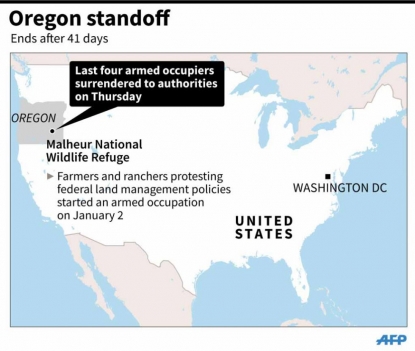 (AFP Graphics)
(AFP Graphics)Now the wildlife refuge is being rehabilitated after weeks of misuse and will likely be ready for the spring arrival of birds that draw thousands of naturalists here every year. Supporters of the occupation vow to continue and speak out against the federal government. The rural parts of the American West are ripe for harvesting this support.
Rob Kerr is a freelance photographer based in Bend, Oregon. Visit his website and follow him on Instagram.
This blog was written with Yana Dlugy in Paris.
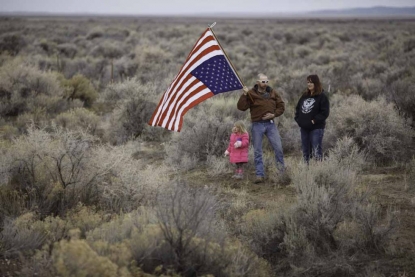 Supporters of the occupiers outside the refuge. February 11, 2016. (AFP / Rob Kerr)
Supporters of the occupiers outside the refuge. February 11, 2016. (AFP / Rob Kerr)
